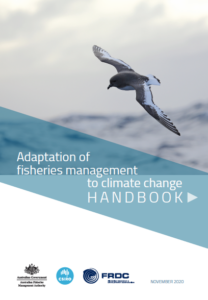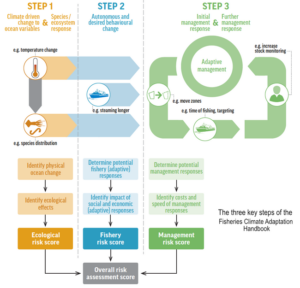Climate Adaptation Handbook
As ecosystems change it can be helpful to understand what change has already happened, what change is expected and how you might adapt.
The CSIRO collaborated with researchers, fisheries managers and fishers from around Australia to create a handbook that sets out the steps to understand:
- the potential sensitivity of individual fisheries to physical and ecological change
- whether the fishery can easily and rapidly autonomously adapt (whether the fishers can change how they fish or their business practices to relieve the pressure on their business or the ecosystem
- or whether a longer process is required that involves changing management plans and modifying the management methods used
A factsheet describing the project is available for download and the handbook is also freely available here.

An online app has also been developed to help track the paperwork of doing an assessment (it takes a user through the steps covered in the handbook). It is available at fishadapt.csiro.au along with its user guide. Nothing is stored on the app server so please remember to download a copy of your work (hit the save icon) or click the “report” link in the app to get a nicely formatted pdf of all your hard work.
The handbook is not set in stone, it should be used as a guide only. It is intended to be used flexibly, anyone using the handbook should modify the steps and details as makes sense for their system and they should seek professional advice specific to their fishery before taking any action to adapt to climate change.
Main steps of the process outlined in the fisheries climate adaptation handbook
Additional Information
Open allClose allIf you would like to join a network of researchers, decision makers and industry members sharing information on adaptation please email us.
The handbook and regional summaries pull together information from many sources. However, one key source was the vulnerability analysis and ecosystem model based projections undertaken in the FRDC funded project on Decadal scale projection of changes in Australian fisheries stocks under climate change. If you would like more information on that work, a short summary of that project and a factsheet for that project are available for download.
Information on observed and expected climate change related shifts on the ecosystems of interest is key information for the handbook’s approach. Regional summaries have been created for locations around Australia to help everyone understand what the next few decades may hold in terms of physical and ecological ecosystem changes.
Oceans and climate are tightly tied together. This means that as the world’s climate changes some of the biggest signatures of that will be in our oceans, affecting the ecosystems and fisheries there. Understanding what that means for specific locations can be difficult, but we have some idea about what the regions of Australia may look like by 2040.
 |
Eastern Australia has already seen a lot of change. In the next two decades the environment will see further change of the same magnitude (if not more) than what has already happened.
It appears that all the species key to the local fisheries and ecosystems are expected to be moderately to highly sensitive to climate change. |
 |
Southern Australia is an ocean climate change hotspot. In the next two decades the environment is very likely to see further change.
Many species in the local fisheries and ecosystems are moderately to highly sensitive to climate change. Declines in abundance and species moving to new locations are likely to continue. |
 |
The oceans around the Kerguelen Plateau (site of Heard Island and MacDonald Island) are becoming more variable, with stronger winds and warmer waters. Sea ice is expected to decrease in future as waters warm further and conditions become rougher.
About half of the species in the region are thought to be at least moderately sensitive to climate change, including species key to the fishery there. |
 |
Western Australia is already warming, with seagrasses, kelp and corals already showing the stress. Change is expected to continue, with conditions seen only in marine heatwaves now expected to extend throughout most of the year.
As all the key species targeted by fisheries are expected to be moderately to highly sensitive to climate change, year-to-year variability of fish stocks is likely to increase. |
 |
Northern Australia has not changed as much as southern Australia, but its waters have warmed, wth more warming expected into the future. Marine heatwaves will last longer, as will droughts (impacting species who rely on rivers).
Most of the species in the region are expected to be moderately to highly sensitive to climate change, including all of the species targeted by the local fisheries. |
2016-059 Guidance on Adaptation of Commonwealth Fisheries management to climate change is supported by funding from the FRDC on behalf of the Australian Government.
Logos of project partners for Project 2016-059 fisheries climate adaptation handbook
Project partners for Guidance on Adaptation of Commonwealth Fisheries management to climate change



